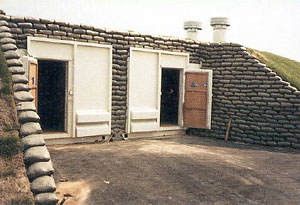What's in This Document
 |
Safety Requirements
Smoking, matches, open flames, and spark producing devices are not permitted: 1) in any magazine; 2) within 50 feet of any outdoor magazine; and 3) within any room containing an indoor magazine. 27 CFR § 555.212.
- Click here for more information on the possession and use of electronic nicotine delivery systems within or near explosives storage magazines.
Generally, detonators cannot be stored in the same magazine with other explosive materials. Detonators that will not mass detonate can be stored in a type 4 magazine with electric squibs, safety fuse, shock tube, igniters, and igniter cord. All detonators can be stored in a type 1 or type 2 magazine with delay devices, electric squibs, safety fuse, shock tube, igniters, and igniter cord. 27 CFR § 555.213.
The following requirements apply only to the storage of explosive materials in type 1, type 2, type 3, and type 4 magazines. 27 CFR § 555.214.
- Explosive materials cannot be placed directly against interior magazine walls.
- Containers of explosive materials must be stored so the marks of identification are visible.
- ATF Ruling 2010-2 allows containers of explosive materials to be stored without the marks of identification being visible provided certain conditions are met.
- ATF Ruling 2012-2 allows display fireworks to be stored in fixed, unmarked, and uncovered bins inside explosives storage magazines.
- Metal containers of explosive materials must not be unpacked or repacked inside a magazine or within 50 feet of a magazine, and must not be unpacked or repacked close to other explosive materials.
- Containers of explosive materials must remain closed while being stored.
- Tools used to open or close containers of explosive materials must be made from nonsparking materials. Metal slitters can be used to open fiberboard containers.
- Metal tools, except for nonsparking transfer conveyors, cannot be stored in any magazine containing high explosives.
The following requirements apply to the interior of all magazines. 27 CFR § 555.215 and 27 CFR § 555.217.
- Magazines must be kept clean and dry. They must remain free of grit, paper, empty packages and containers, and rubbish.
- Brooms and other utensils used in the cleaning and maintenance of magazines must have no spark-producing metal parts.
- Magazine floors stained by leaking explosive materials must be cleaned according to the explosives manufacturer’s instructions.
- Deteriorating explosive materials must be destroyed according to the explosives manufacturer’s instructions.
- Battery-activated safety lights/lanterns may be used in magazines.
- Electric lighting must meet the standards prescribed by the National Electrical Code for the conditions present in the magazine at any time.
- Electrical switches must be located on the outside of the magazine.
The following requirements apply to areas around the magazines. 27 CFR § 555.215.
- A 25-foot perimeter around the magazine must be kept free of rubbish, brush, dry grass, and trees (except live trees over 10 feet tall).
- Volatile materials are restricted from being within 50 feet of any outdoor magazine.
Before repairing the interior of magazines, all explosive materials must be removed and the interior cleaned. Before repairing the exterior of magazines, all explosive materials must be removed if there exists any possibility that repairs may produce sparks or flame. Explosive materials removed from magazines under repair must be (a) placed in other magazines appropriate for the storage of those explosive materials under this subpart, or (b) placed a safe distance from the magazines under repair where they are to be properly guarded and protected until the repairs have been completed. Refer to 27 CFR § 555.216.

